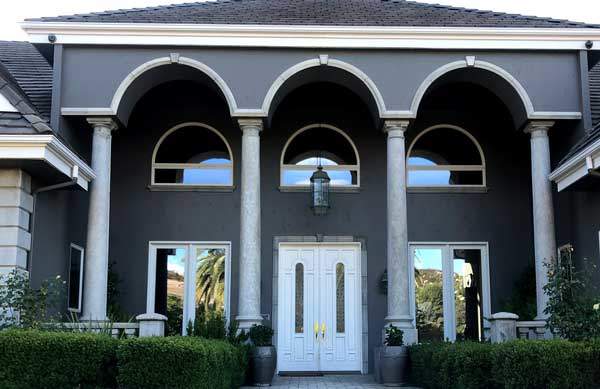Top Advantages of Setting Up Residential Window Tint for Your Home
Exactly How Residential Home Window Tinting Enhances Your Home's Power Effectiveness
Residential window tinting provides a compelling solution for homeowners seeking to enhance power performance within their home. By applying specialized movies to home windows, it efficiently reduces warmth transfer, consequently maintaining indoor temperatures and lessening the demand for excessive heating or cooling. This not just cuts power consumption however likewise provides a more comfy setting by alleviating glare. Nevertheless, comprehending the subtleties of exactly how tinting works and choosing the appropriate kind for your home can be essential. Oddly, what factors should one take into consideration before making this financial investment?
Understanding Home Window Tinting
Comprehending home window tinting is necessary for house owners seeking to boost both comfort and energy performance in their home. Residential Window Tint. Home window tinting entails the application of a slim movie to the inside or outside surface of glass windows. This film can substantially regulate the quantity of sunlight and warm that enters a home, thus influencing indoor climate conditions
There are various kinds of home window tinting films readily available, each with distinctive residential or commercial properties. Colored movies soak up solar energy, while reflective films disperse it away from the glass surface. Ceramic films provide an equilibrium of exposure and heat rejection, making them a popular selection amongst house owners. The performance of window tinting is often measured by its Visible Light Transmission (VLT) percent, which indicates just how much light can travel through the movie.
Benefits of Energy Efficiency
Window tinting not only improves aesthetics however additionally plays a significant function in boosting energy efficiency within domestic rooms. By lowering warmth transfer with windows, colored films produce a more secure interior environment, which can cause considerable decreases in energy usage for heating & cooling. This power effectiveness translates into reduced utility expenses, offering homeowners with substantial long-lasting savings.

In addition, window tinting improves the comfort of living rooms. By lessening glare and blocking unsafe UV rays, colored windows create an even more enjoyable environment, which can bring about boosted wellness for occupants. The defense against UV rays additionally aids preserve furnishings and flooring from fading, adding to the durability of house products.
How Tinting Functions
Tinting films run through a combination of advanced products and technologies made to manage the quantity of solar power entering a home. Largely made up of polyester, these films usually integrate ceramic or metal particles that show and absorb heat. This double capacity allows them to dramatically decrease the infiltration of ultraviolet (UV) rays and infrared radiation while allowing noticeable light to pass through.
The efficiency of home window tinting is measured by its solar heat gain coefficient (SHGC), which shows how much solar power is sent through the window. Reduced SHGC worths are more effective as they represent greater warm denial. In addition, window tints can feature a selection of tones, allowing house owners to tailor their aesthetic preferences while enhancing energy effectiveness.
Moreover, these movies act as a barrier, stopping warmth loss throughout chillier months by mirroring indoor heat back right into the living space. This thermal insulation effect matches the air conditioning advantages obtained throughout warmer months, adding to a balanced interior environment year-round. By taking care of solar power effectively, domestic home window tinting not only enhances comfort but also plays a vital function in minimizing power intake and decreasing energy expenses.
Selecting the Right Tint

There are numerous types of home window movies readily available, consisting of colored, metalized, and ceramic. Dyed films are cost-efficient but may have limited longevity. Metalized films use far better heat being rejected but can hinder digital signals. Ceramic movies provide outstanding warmth control without endangering visibility and are extremely long lasting, making them a preferred choice.
Noticeable light transmission (VLT) is one more critical factor, as it indicates the quantity of natural light that can go through the colored glass. Home owners should select a color with a VLT that complements their lighting preferences while still providing adequate glare decrease.
Additionally, assessing the solar heat gain coefficient (SHGC) can help determine how well a color can obstruct warmth from sunshine. A lower SHGC indicates better heat control, eventually enhancing power effectiveness.
Installment and Upkeep Tips
Proper installment and maintenance are crucial components in taking full advantage of the benefits of property window tinting. Experts also utilize specialized strategies and tools, which can improve the durability and efficiency of the color.
Adhering to installation, maintenance is necessary to lengthen the life of the home window film. It is recommended to wait at least 30 days before cleaning up the colored home windows to permit the glue to treat totally.
Attending to these concerns quickly can stop more damages and keep power effectiveness. By adhering to these installment and upkeep ideas, home owners can ensure their window tinting proceeds to supply considerable energy financial savings and convenience for years to come.
Final Thought
In conclusion, household window tinting offers as view website a reliable service for boosting energy performance within homes. By decreasing warmth transfer and blocking damaging UV rays, home window films add to decrease energy usage and boosted indoor comfort.
Home window tinting involves the application of a thin movie to the inside or exterior surface of glass windows. By decreasing warmth transfer through windows, tinted movies develop a more stable interior environment, which can lead to substantial reductions in power consumption for heating and air conditioning.The performance of window tinting is measured by its solar warm gain coefficient (SHGC), which indicates exactly how much solar power is sent via the home window. By managing solar energy successfully, residential window tinting you could look here not only improves convenience yet also plays an essential duty in minimizing power intake and decreasing utility expenses.
By minimizing warmth transfer and obstructing harmful UV rays, window films contribute to lower power usage and enhanced indoor comfort.